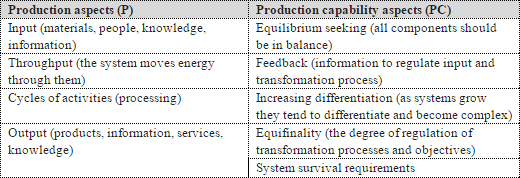
Goods or services
The first column describes functions that are primarily concerned with producing goods or services. Production processes need maintaining processes in order to survive. The ability to produce goods should be well maintained due to the inherent tendency of systems to decay. Prevention of decay should be established by performing certain maintenance functions.
Table: Components of a cybernetic system

Both aspects should be in balance
For an organization to survive in the long run, it is necessary that both aspects are in balance, production as well as production capability (Covey, 1989). In the next blog, I go into more detail about the cycle of activities (processes) and the differentiation that occurs when organizations tend to grow. This differentiation leads to steady, formal organizational structures wherein processes are performed.
- Managers are steering the car and they are primary concerned about two things: driving (production) and maintaining the driving system (production capability). According to Covey, these aspects should be in balance. This information can be depicted as a pair of scales that dynamically change with the arrival of new data. Since this generic principle of management applies to all organizations and reveals therefore no variation, this business principle is classified as second class knowledge. However, this type of business logic can be integrated into an interface of the business intelligence application as standard in order to help senior managers to maintain the balance in the organization.
- Although the principal alone reveals no variation, the speed at which the balance is going up and down over time does reveal variation. If the weight of the P side of the balance increases at high speed, a stronger signal can be selected. This rule is similar to the principle of importance ordering that states that more important information should be encoded more effectively (Mackinlay, 1986). These results are not only true for the P/PC balance principle but can also be applied to all variations over time. The higher the rate of increase or decrease of a measure the more effective encoder can be selected.
Business intelligence - goals and objectives
Organizations have goals and objectives, which are necessary to make appropriate decisions. In this blog we investigate the variations in this domain that can be used to optimize the user interface of business intelligence solutions and dashboards. These goals can be multi-fold and are related to (Keuning and Eppink, 1993):
- profitability
- productivity and added value
- being extremely good at doing some kind of work
- social responsibility in employment or environmental issues
- growth and continuity
- salary
- work climate
- status and authority
- market share
Important pieces of information for the manager
I assume that the goal defined above is measurable and is an important piece of information for the manager in order to determine whether or not the ‘car is going in the right direction’. Therefore, the goal should be visible on the screen (if there is one) or at least be retrievable using bi tools. A goal or objective has a number of properties that are important in relation to the design of the user interface. The following properties reveal variation:
- type of goal (variable among different types of organizations)
- degree to which the goals are met (variable over time)
- the speed at which the goals are accomplished or not (variable over time)
- term of the goal (variable within the organization)
Those variations can lead to different metaphors (e.g. type of goal) and to the precision of the time dimensions (e.g. term of the goal). Short-term goals that are evaluated against the current situation should have a more detailed time dimension than long term goals.
No comments:
Post a Comment